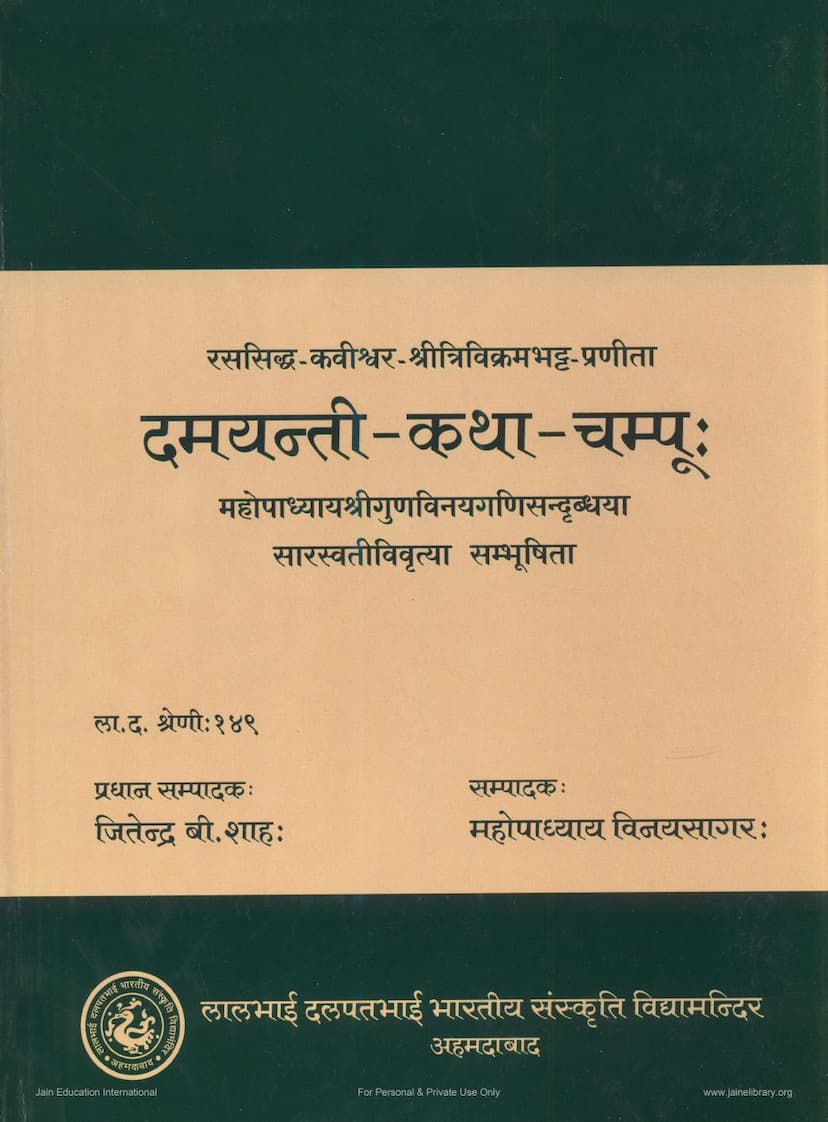Damyanti Katha Champu
Added to library: September 1, 2025

Summary
This is a comprehensive summary of the provided Jain text, "Damyanti Katha Champu" by Vinaysagar, focusing on the key aspects of the publication and the content as described in the text.
Comprehensive Summary of Damyanti Katha Champu by Vinaysagar
Book Title: Damyanti Katha Champu (also referred to as Nal Champu) Author: Vinaysagar (editor/annotator), Original Author: Trivikramabhatta (as per the publication details) Publisher: Lalbhai Dalpatbhai Bharatiya Sanskriti Vidyamandir, Ahmedabad Catalog Link: https://jainqq.org/explore/004071/1
This publication presents the Damyanti Katha Champu, a significant work in Sanskrit literature, originally authored by the esteemed poet Trivikramabhatta. The text is brought to light with a detailed commentary and extensive annotations (Saraswati Vivriti) compiled by Mahopadhyay Vinaysagar. The primary editor of this edition is Jitendra B. Shah, with Mahopadhyay Vinaysagar serving as the editor for the literary aspects. The first edition was published in 2010 with a print run of 500 copies.
Key Features and Content:
The Damyanti Katha Champu is recognized as the first and perhaps the most ancient Champu Kavya (a literary genre that blends prose and poetry). The author, Trivikramabhatta, is lauded as a pioneer and master of this genre, particularly noted for his skillful use of shlesha (puns and double meanings), which he employs with great elegance and fluidity, even surpassing the renowned Subandhu in his mastery of this technique. The work is based on the well-known story of Nala and Damayanti, drawn from ancient Indian epics, but is presented with Trivikramabhatta's unique literary flair and elaborate descriptions.
The text is divided into seven Uchchavasas (chapters), each concluding with the auspicious phrase "Haricharanasarojank" (marked by the lotus feet of Hari). The summary provides a chapter-wise breakdown of the narrative:
- First Uchchhasa: Begins with auspicious invocations to deities and eulogy of poets, followed by the introduction of Trivikramabhatta's lineage and the description of Aryavarta, the land of Nishadha, and its king Nala. It details Nala's minister Shrutsheel, Nala's leisurely life, his hunt, and his first encounter with a hint about Damayanti through a traveler.
- Second Uchchhasa: Covers the arrival of autumn, Nala's increased longing, his encounter with a swan, the swan's message, and the introduction of Damayanti's lineage, king Bhima of Vidarbha, and his queen Priyam Manjari's devotion to Lord Shiva for a child.
- Third Uchchhasa: Continues with Priyam Manjari's dream, Shiva's boon, the sage Damanaka's visit, and the prophecy of Damayanti's birth. It details Damayanti's upbringing, education, and blossoming beauty.
- Fourth Uchchhasa: Narrates Nala's growing impatience upon hearing about Damayanti's beauty from the swan. It also provides a detailed account of Nala's own royal lineage, his minister Shrutsheel, and a moral discourse from Salankayana.
- Fifth Uchchhasa: Describes the swan's journey to Kundinapur, Damayanti's encounter with the swan, and her reciprocating the swan's message to Nala. It also covers the preparations for Damayanti's svayamvara (self-choice ceremony) and the arrival of various celestial kings.
- Sixth Uchchhasa: Details the events leading up to the svayamvara, including Nala's journey to Vidarbha, his encounters with travelers and celestial beings, and the messages exchanged through the swan. It touches upon the nature of champyakavya and the poet's skill in blending prose and poetry.
- Seventh Uchchhasa: Concludes the narrative with Damayanti's pivotal choice at the svayamvara, her unwavering devotion to Nala despite divine temptations, and ultimately, her reunion with him. The text also includes an introduction to the commentator, Gunavinya Gani.
Trivikramabhatta's Background:
The introduction provides insights into the author, Trivikramabhatta, placing him in the 10th century CE. It traces his lineage, highlighting his family's scholarly and ritualistic traditions. He is identified as a court scholar in the Rashtrakuta dynasty, specifically serving Indraraja III. The text also delves into his extended family, including his son Bhaskara Bhatta, who was honored by King Bhoja, and further descendants who achieved prominence in astronomy and other fields. Trivikramabhatta is noted for his poetic prowess, his deep knowledge of various languages (Sanskrit, Prakrit, Apabhramsha), Jain philosophy, and literature. His works often feature intricate shlesha (puns) and captivating descriptions of nature, mythology, and human emotions.
The Commentary by Mahopadhyay Vinaysagar:
Mahopadhyay Vinaysagar is presented as a scholar well-versed in Sanskrit, Prakrit, and Apabhramsha languages, and deeply knowledgeable in Jain philosophy and literature. His commentary, "Saraswati Vivriti," is instrumental in illuminating Trivikramabhatta's complex literary techniques and philosophical undertones. The publication is appreciated for its comprehensive editorial work, including detailed content analysis and character listings, which aids readers in understanding the narrative and its nuances.
Overall Significance:
The Damyanti Katha Champu is celebrated for its poetic excellence, its intricate wordplay, and its contribution to the Champu genre. This edition, with its scholarly annotations, makes the work accessible to a wider audience of Sanskrit literature enthusiasts and scholars. The publication also highlights the rich literary heritage of Jain traditions and the significant contributions made by Jain scholars to classical Indian literature.